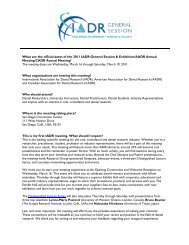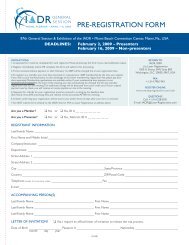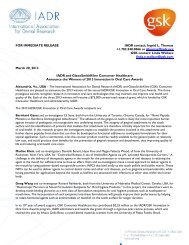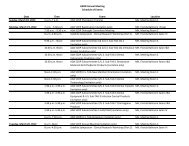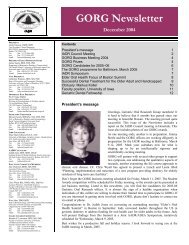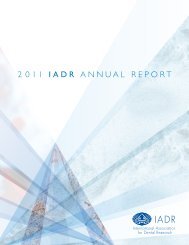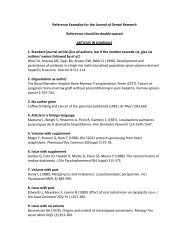Contents - IADR/AADR
Contents - IADR/AADR
Contents - IADR/AADR
Create successful ePaper yourself
Turn your PDF publications into a flip-book with our unique Google optimized e-Paper software.
necessary for physicists to further refine measurements. Perhaps no better example of this weakness may be<br />
offered than that of Alfred Russell Wallace, who, summarizing the scientific achievements of the nineteenth<br />
century in 1901, pointed to the rejection of the study of phrenology by the scientific community as one of the<br />
most unexplainable failures of an otherwise brilliant period. For Wallace at the opening of the twentieth century<br />
it seemed that phrenology had been one of the greatest scientific breakthroughs of the preceding seventy years.<br />
But if some scientists had developed a sense of complacency by the turn of the century, and if others were<br />
willing to judge the developments in fields other than their own with something less than the eyes of experts,<br />
the scientific world was in reality in the opening stages of what may now be called a second revolution in<br />
science. Surely many factors contributed to this development, but for the purpose of this short essay we may<br />
limit ourselves to only a few. Above all, looking back from the third quarter of the twentieth century, it is<br />
obvious that a number of spectacular discoveries sparked by scientific genius contributed to a rapid series of<br />
advancements. Classical concepts in the physical sciences were overturned in the closing decade of the old<br />
century and the opening decades of the new one. In their place new concepts, hypotheses, and theories were<br />
postulated at a pace that bewildered the scientist then, no less than it does the historian today who attempts to<br />
reconstruct that era. And yet perhaps no less important for an understanding of twentieth-century science than<br />
these internal developments within the sciences were the parallel origins of a new union of science, industry,<br />
and government in the late nineteenth century—a union that was essentially nonexistent in earlier periods. Here<br />
the result was to create a demand for scientists that the universities with new teaching methods quickly filled.<br />
And, as newly research-oriented industries began to affect the economic well-being of nations, scientific<br />
research inevitably became a matter of concern to politicians and their governments.<br />
It would be impossible to list adequately the major scientific developments of the past eighty years. At<br />
best one can point to a few of the more significant areas of change. Nowhere had change been less expected<br />
than in physics. Here the spectacular discovery of X-rays by Roentgen in 1895 quickly impressed itself on the<br />
scientific world as well as the public. While music-hall comedians pointed to the girls in the chorus and sang<br />
songs such as "X-Rays Will Give It Away" (ca. 1899), scientists were engaged in work which led in turn from<br />
radioactivity to a whole set of new elements and then on to the problems of nuclear physics. In the course of a<br />
few decades this discovery resulted in a knowledge of how atoms are arranged in solids. And, if we may trace<br />
these developments through to the solid-state physics of the present, we may point to a second contemporary<br />
major development in the physical sciences in the early part of the new century. At that time a new synthesis of<br />
the relative character of motion and of the relationship between mechanics and optics led to both the special and<br />
the general theories of relativity. With the latter, a far more satisfactory explanation of cosmological phenomena<br />
has been made possible. In chemistry, as the fields of biochemistry and physical chemistry developed, a heavy<br />
emphasis has been placed on structural problems. The search for answers to biological questions through the<br />
INTERNATIONAL ASSOCIATION FOR DENTAL RESEARCH (<strong>IADR</strong>) – THE FIRST FIFTY YEAR HISTORY PAGE 3



